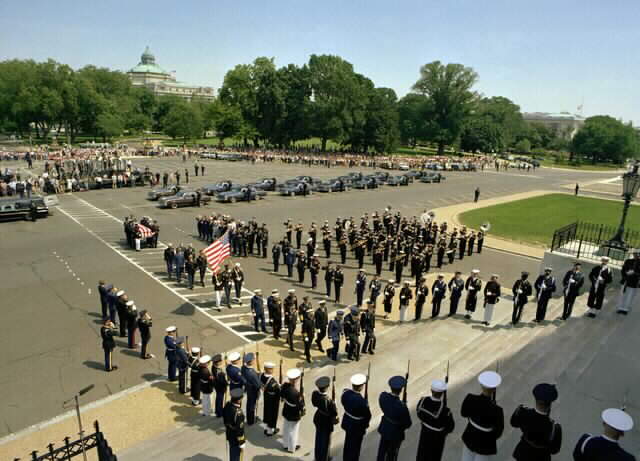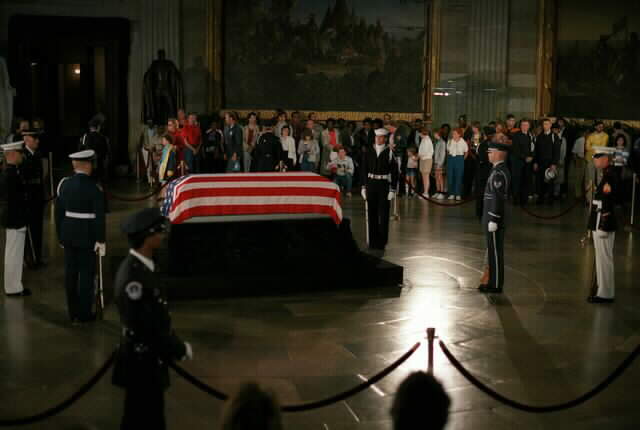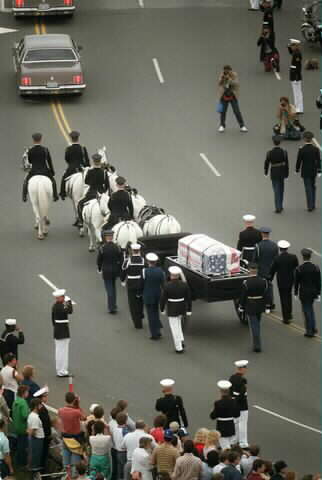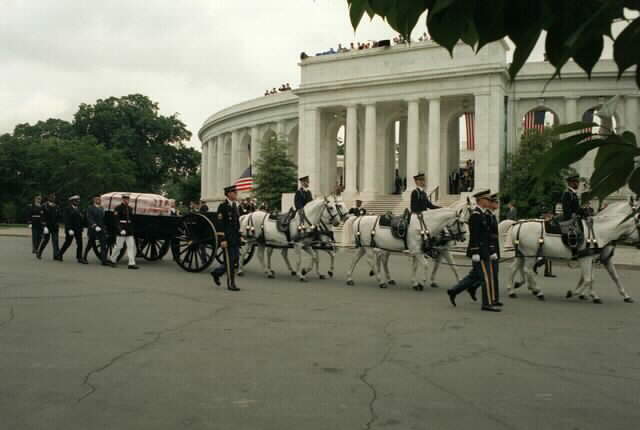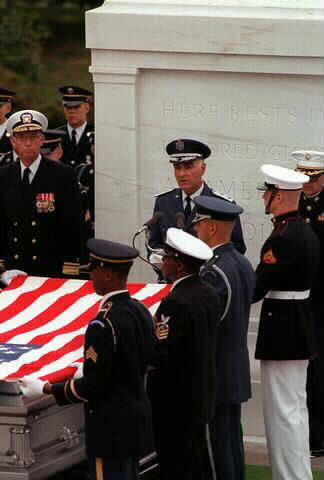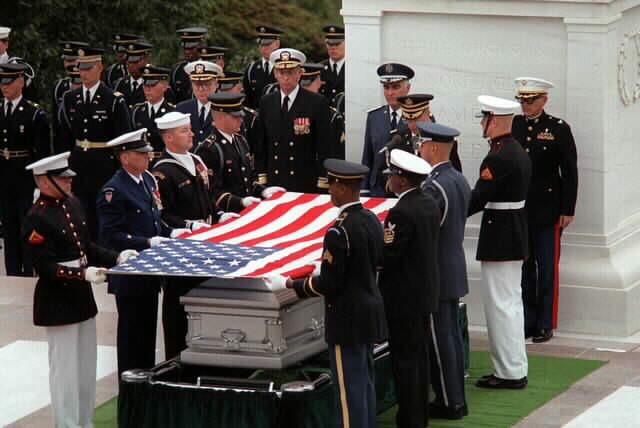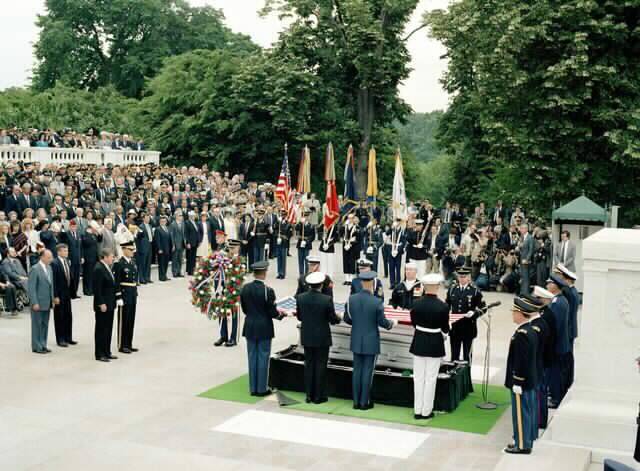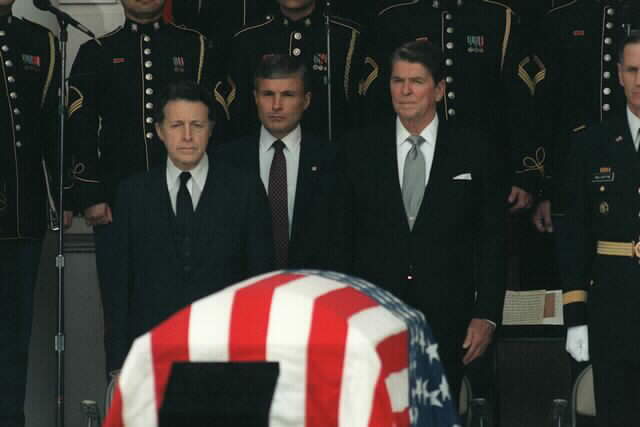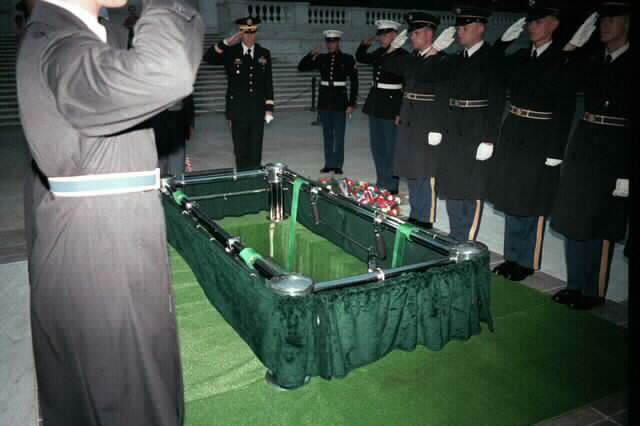From a 1984 News Report: National Review
It is the ultimate symbolic gesture, one long delayed by the humane ends of advanced technology and the endless controversies that plague every aspect of the enterprise even Archie Bunker was eventually moved to call “that damn war.”
There are only two sets of partial unidentified remains from the Vietnam conflict, and military pathologists are confident that they will eventually identify one of them. The rules regarding completeness had to be suspended in order that these fragments of a man, the one unidentifiable soldier, might come to rest beside the bodies of his brothers from Korea and World Wars I and II.
Vietnam veterans for the most part interpreted, in their accustomed way, the decade of delay in selecting and interring an unknown comrade as yet another of the many real or imagined insults and omissions they have endured for their participation in our nation's first true bastard war. But on Memorial Day 1984 the applicable precedents at Arlington National Cemetery went back three wars, and the pomp and ceremony were entrusted to experts.
Eight resplendent, sweating young representatives of all the services–most of whom were probably in grade school when this soldier fell–carried the flag-draped coffin forward gracefully, with immense dignity, and set it down directly in front of their commander-in-Chief.
The President spoke eloquently of sacrifice and freedom and reminded his audience that the American armed forces in Vietnam “were never defeated in battle.” He awarded the Medal of Honor to the Unknown and devoted much of his speech to an invitation to Hanoi “to heal the war's sorest wound” by providing an accounting for those still missing. The President received the folded flag from the honor guard, and a bugler blew “Taps.”
What was done was altogether fitting and proper. Just as Lincoln's dedication of the hallowed ground at Gettysburg did not distract him or his nation from the task still before them, neither should the entombment of the Unknown Soldier of the Vietnam War distract us from the cause of freedom for any prisoners left behind, and for all men everywhere. Regardless of the controversy, we should be glad this day. For here rests in honored glory an American soldier known but to God.
Vietnam War Unknown
The nature of war in Vietnam and advances made in forensic medicine nearly thwarted the efforts to designate a Vietnam Unknown. Unlike earlier wars, where the deceased might remain unattended for weeks at a time, medical evacuation teams in Vietnam were often on battlefield while fighting still raged. In addition, because firefights were limited to units of company-size or smaller and were contained in small areas, identification of dead was relatively easier than before.
In World War II, 75% of casualties were caused by the more destructive forces of artillery shells and mortars; only 10% were wounded by gunfire. Gunshot wounds, by comparison, accounted for 40% of casualties in Vietnam with enemy mortars or artillery responsible for 21%. That helped in identifying casualties. Technical advances, along with detailed military and medical records, enabled medical scientists to identify nearly all remains, including those returned after hostilities ceased.
The Army's Central Identification Laboratory in Honolulu, Hawaii, even used the technique known as photo superimposition to identify remains. Computers would reconstruct facial features so they could be compared with photographs of servicemen listed as missing. The emotional stress on those whose loved ones were still unaccounted for in Southeast Asia also played a role in delaying the designation of a Vietnam Unknown.
The National League of POW-MIA Families opposed entombment of an Unknown. Spokesman for that organization told reporters, “The major problem is that they could be interring somebody who might be eventually be identified.” But in late 1970s Vietnam veterans began pressing their Congressmen to expedite the designation of an Unknown. They saw delay as further evidence of the country's rejection of their svce and sacrifices. Support for their cause came even from American Legion, who began pushing the issue. But government would not be hurried. Responding to critics, White House issued a statement: “We have resisted congressional and veterans' groups pressure to rush the process, thus ensuring integrity for the families. The burial will be an act of national unity that will spark greater public awareness that the Vietnam War is not behind us.”
By 1982 only 4 sets of unidentified remains were held in Army's laboratory. While this was an obvious relief for families of the missing, it posed a further dilemma for those campaigning for an Unknown. There was a strong possibility that the remains would eventually be identified. That's exactly what happened to two of them. Then, the third set was thought to “possibly not be American,” according to the Army. Chances were good the body was that of Southeast Asian. That left one set of remains. An Army spokesman said, “Information we have on this individual does not match anything we've got.”
All they knew was that the casualty died after 1973, but was not one of the remains returned to US control by the Vietnamese after 1975. Though it happened by default, an Unknown from Vietnam finally existed. To preserve casualty's anonymity, Army ordered all records pertaining to the case destroyed. Personnel at Army's identification laboratory were told not to discuss any aspect of the investigation. An Army spokesman said, “He's an American. We know he died in the conflict, but we just don't know who he is. We used every trick, but we cannot match him to any known missing soldier. We think we can say this a true Unknown from the Vietnam War.”
Official designation of the remains took place May 17, 1984. In a dockside ceremony at Pearl Harbor Naval Base, US Marine Corps Sergeant Major Allan J. Kellogg placed a wreath at the foot of the casket. Kellogg had earned the Medal of Honor in Vietnam in 1970 by throwing himself on an enemy hand grenade. Pallbearers then placed the casket aboard the USS Brewton to start long voyage to Washington, DC Once there the casket lay in state in the Capitol Building's Rotunda. Thousands filed by casket to pay their respects.
At noon, Memorial Day, May 28, a military funeral procession carried the casket to Arlington National Cemetery. In the Memorial Amphitheater hundreds of invited guests, including over 100 Medal of Honor recipients from all wars, joined tens of thousands of spectators viewing the ceremonies on national television. Honorary pallbearers were Vietnam Medal of Honor heroes from each military branch: Walter J. Marm and Jon R. Cavaiani, US Army; Jay Vargas and Allan J. Kellogg, US Marine Corps; James W. Williams and Michael E. Thornton, US Navy; and George E. Day and James P. Fleming, US Air Force.
President Reagan gave an emotionally-charged speech during the somber funeral service.
“Today we pause to embrace him and all who served so well in a war whose end offered no parades, no flags, and so little thanks. About him we may well wonder as others have: As a child, did he play on some street in a great American city? Did he work beside his father on a farm in America's heartland? Did he marry? Did he have children? Did he look expectantly to return to a bride? “We will never know the answers to those questions about his life. We do know, though, why he died. He saw the horrors of war but bravely faced them, certain his own cause and his country's cause was a noble one, that he was fighting for free men everywhere.” President Reagan then assured the families of MIA's the quest for their loved ones was not over. “We write no last chapters,” he said. “We close no books. We put away no final memories.” The President then presented the Medal of Honor by stating we should “debate the lessons learned at some other time: Today we simply say with pride, ‘Thank you, dear son. May God cradle you in His loving arms.' We present to you our nation's highest award, the Medal of Honor, for service above and beyond the call of duty in action with the enemy during the Vietnam Era.”
In 1973 Congress directed the Secretary of Defense to select an unknown Vietnam serviceman to represent all the dead of the war that had divided the country more than any other since the Civil War. In 1975 a crypt was built at ANC's Tomb of Unknowns to contain these remains, but for years it stayed empty.
In 1921 when the first unknown soldier – a casualty from World War I – was buried at ANC, there were more than 1600 unidentified remains to choose from. On May 30, 1958, when an unknown soldier from World War II was honored, there were over 8500 to choose from. The same day, an unknown soldier from Korea was also interred, and there were over 800 to choose from. Because of prompt evacuation of dead and wounded by helicopter, improved military record-keeping, and scientific advances in identification, there had never been more than four Vietnam unknowns at the CIL (Central Identification Laboratory, headquartered in Hawaii) at any one time.
Groups like the National league of Families had successfully fought selection of a Vietnam unknown, because they feared it would lead to a slackening of government efforts to search for individuals still unaccounted for. In the spring of 1984, however, pressure from groups like the Veterans of Foreign Wars and American Legion combined with the Administration's eagerness to make a controversial war more respectable by honoring those who had fought in it resulted in a Defense Dept decision to choose a Vietnam unknown from the four remains then at the CIL.
In choosing an unknown from earlier wars, an administrative procedure of forgotten origin was followed: only remains that were as much as 80 percent complete were selected. These so-called “best” remains of 1920s and 1950s were worst choices in the 1980s, because of the progress in identification techniques, so the criterion of 80 percent was waived for the Vietnam unknown soldier. One of the four remains at CIL in early 1984 was ruled out because it was 95 percent complete. The second remains, which had been turned over the by Vietnamese in 1983, was not a candidate, because Dr. Furue had successfully superimposed a scapula from the remains over a chest X-ray from the record of one of the unaccounted-for, and in CIL's opinion there was an excellent likelihood of identifying him if the Vietnamese turned over additional remains. The third remains at CIL had been part of a 1978 turnover of four from Laos.
One of the four had been identified as an American US Air Force pilot, but two others had proven to be Southeast Asian Mongoloids. The bones of the fourth were those of a Caucasoid, but there was no evidence that he had been a soldier. The fourth remains at CIL at the beginning of 1984 had been found by a South Vietnamese Army reconnaissance team in late 1972 near a town about 60 miles north of Saigon. The remains were eventually given number X-26. They consisted of 6 bones. Along with the remains, which were only 3 percent complete, reconnaissance team had brought in a few objects such as remnants of a flight suit, of a pistol holster, and of a parachute, and a one-man inflatable raft. Furue determined that X-26 was Caucasoid man of average muscularity, whose height had been approximately 68.4 inches and who had been between 26 and 33 years old. The only men KIA-body-not-returned category within a 2500 square mile area of where X-26 had been found were 2 men in helicopter and the pilot of a fighter plane; both aircraft had crashed, as it happened, May 11, 1972.
Several Sergeants at CIL were convinced that X-26 was one of the two men from the helicopter, but Future was not certain. The Vietnamese reconnaissance team's report had been disturbingly vague, and condition of the 6 bones – they showed no evidence of trauma – was at variance with accounts of both crashes. Furue was asked to go to Washington, DC and recommend to National League of Families that X-26 be chosen as Unknown Soldier of Vietnam War. He declined to go. He believed that if additional remains of X-26 were ever found he could identify him.
On April 13, 1984, Caspar Weinberger designated X-26 as remains that would be buried at Aarlington. Johnnie Webb and Tadao Furue refuse to discuss the Vietnam Unknown. “Putting X-26 in the Tomb of the Unknowns was politically expedient,” a former CIL Sergeant says. “At best, it was premature. I'll bet Doc considered him unidentified but not unidentifiable. Perhaps it was appropriate to the Vietnam War. So much else about it was political. Everything connected with X-26 has been ordered shredded, but you can't shred what's in men's minds. If we ever get into South Vietnam, the way we got into Laos, and find additional remains that match those in ANC there could be a problem.”
May 30, 1983:
Twenty-five years ago the remains of two unidentified servicemen, one from WWII and the other from Korea, were laid to rest at Arlington National Cemetery. Among the hundreds of groups that participated in the ceremony was an honor guard from the Veterans of Foreign Wars, a group of 71 men composed of veterans from Pennsylvania and the Washington area.
Yesterday, in the dreary morning rain, some who had been in that contingent gathered again at the Tomb of the Unknown Soldier to commemorate that day in May 1958 and the special meaning that it holds in their lives. The boot heels still clicked smartly, and the salutes were crisp despite the soggy climate when the wreath of red and white chrysanthemums was placed before the memorial grave. A four-man color guard flanked the tomb, while the other veterans faced it in salute. A bugler played taps as the crowd of about 100 stood in silence.
The date of the reunion, on the eve of Memorial Day, was chosen to allow the groups from Pennsylvania to return home today in time to participate in their local observances. The official commemoration of Memorial Day will take place at Arlington today at 11 a.m. when Deputy Secretary of Defense Paul Thayer, representing President Reagan, will lay a wreath at the tomb. A plaque representing the unidentified dead from the Vietnam war will be dedicated and placed at the shrine at 11 a.m. Yesterday, after their brief ceremony, the 19 veterans posed on the steps of the amphitheater as wives and fellow veterans took pictures for the veterans' posts back home. After a quarter of a century, some of the details of that earlier ceremony may have blurred, but all of the group remembered standing at “Present arms” on the grassy slope opposite those steps for what had seemed like hours after a five-mile parade on what was recalled as a scorchingly hot day. “It must have been in the nineties,” said Robert Keck, 57, one of eight “originals” who returned from the Millersville Pa. VFW group. “I had heard it was about 82 degrees,” said Raymond Herr, 65, also from Millersville. “It had to be in the nineties,” Keck insisted. “Some of the guys on the bridge were dropping like flies.” Whatever the temperature, it was important to remember, everyone agreed, that while some of the younger, active servicemen wilted that day, the contingent from the VFW never faltered. Bill Ross, a member of the Washington-based VFW National Honor guard from Hyattsville, said that he was proud to stand in tribute at the memorial again, even in the rain. The men pointed out that the VFW is the only organization not an active military unit that is permitted to perform in ceremonies held at the Tomb of the Unknown Soldier. “Basically, underneath it all, when the chips are down, patriotism is still there,” said Ross. “I would have stood there all day, if need be.” “You'd best believe it,” chimed in Howard Collier, a truck driver from Media Pa., who said that he had been thinking about this visit while driving his 75-mile route every day since January. “It's just been creeping up inside me for months,” said Collier. Bill Brady, 61, another veteran from Media, recalled that the VFW unit was “the lowest on the totem pole” 25 years ago, when hundreds of military groups marched ahead of them in the parade on Constitution Ave, but that they probably stood closest to the remains of the unknown servicemen that were entombed that day, “right there, in front of the caissons.” The Arlington Memorial Amphitheater was dedicated in 1920. The following year, the remains of an unknown soldier from World War I were interred there and in 1931 the original tomb, a solid block of marble, was completed. The Tomb of the Unknown Soldier originally was dedicated as a memorial to the unidentified dead of World War I. It was expanded when, on May 30, 1958, the remains of unidentified servicemen from World War II and the Korean conflict were entombed there. VFW members, Brady said, take special pride in guarding the memories of those who have served their country, and for many it is their dream to be buried with other veterans in their home communities or in Arlington Cemetery. “Maybe a psychologist would say it's just a desire to return to a group, where you were a unit and were trained together,” Brady said. “You get that feeling.”
The Unknown Of Vietnam
Photograph Coverage
(Photos Courtesy of The Defense Department)
The Vietnam Unknown Arriving At The United States Capitol
The Vietnam Unknown Lying In State At The United States Capitol
The Vietnam Unknown's Processing From The United States Capitol
To Arlington National Cemetery
The Vietnam Unknown Arrives At Arlington National Cemetery
Interment Service For The Vietnam Unknown
At Arlington National Cemetery
Interment Service For The Vietnam Unknown
At Arlington National Cemetery
Interment Service For The Vietnam Unknown
At Arlington National Cemetery
President Reagan Represents America At The Interment
Of The Vietnam Unknown At Arlington National Cemetery
The Vietnam Unknown Is Lowered Into His Crypt
At Arlington National Cemetery
Michael Robert Patterson was born in Arlington and is the son of a former officer of the US Army. So it was no wonder that sooner or later his interests drew him to American history and especially to American military history. Many of his articles can be found on renowned portals like the New York Times, Washingtonpost or Wikipedia.
Reviewed by: Michael Howard

